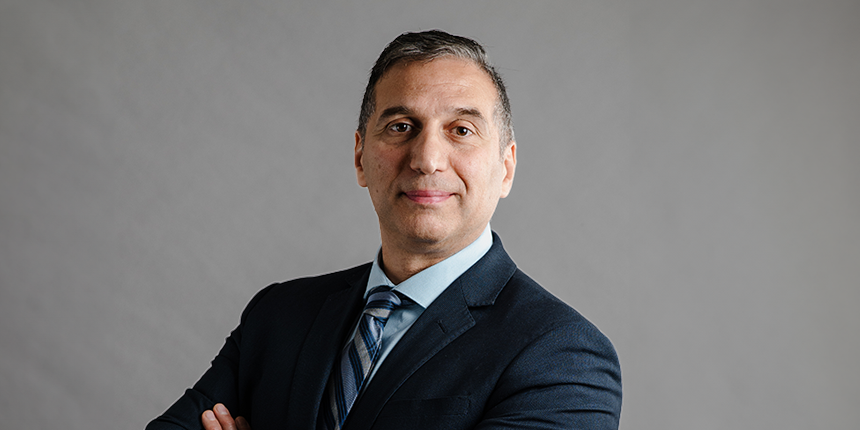

At the beginning of August, Philip Rizcallah joined Engineers Canada as the organization’s new Chief Executive Officer. He comes to us from Accessibility Standards Canada where he was the federal departmental corporation’s first Chief Executive Officer. In that role, he spearheaded the development of several standards and research projects helping to remove barriers to accessibility for persons with disabilities.
Engineering Matters sat down with Rizcallah to discuss the first month in his new role.
Engineering Matters: What are your initial impressions of Engineers Canada and the work we do?
Philip Rizcallah: It is clear to me that Engineers Canada plays a pivotal role in advancing the Canadian engineering profession both nationally and internationally.
The organization leads a diverse portfolio. Accreditation of undergraduate engineering programs is well known, where we ensure graduates of such programs meet the academic requirement for licensure, fostering a high level of confidence among employers that graduates are ready to enter the workforce regardless of which higher education institution they have graduated. In addition, we’re also advocating on behalf of engineers to governments on policy matters impacting the profession, collaborating with engineering regulators to promote consistency and mutual recognition, and working tirelessly to advance diversity and inclusion in the profession. Through programs such as 30 by 30 we hope to encourage more women to enter the profession of engineering.
EM: What comes to your mind when you consider Engineers Canada’s vision, “advancing Canadian engineering through national collaboration”?
PR: When I think about Engineers Canada vision to advance Canadian engineering through national collaboration, I think of Canada’s federated system. It’s not unlike my previous work with the federal government and my collaboration with provincial and territorial government partners: each entity plays a crucial, yet unique role, in a governance ecosystem. In the case of the engineering profession, the regulators are responsible for licensing and regulating the engineers in their respective jurisdiction. Engineers Canada on the other hand, strengthens national and global confidence in the profession through accreditation, collaboration, consistency, and encourages labour mobility of both nationally and internationally trained engineers.
EM: As the new CEO, what are you focussing on first?
PR: My priority is to understand our team and the work we are doing, ensuring it aligns with the Board of Directors' mandate, vision, and mission. As I engage with various interest holders, particularly our jurisdictional partners and educational institutions, I aim to better understand their needs and how Engineers Canada can address those needs through national initiatives. This is also the last year of Engineers Canada’s current strategic plan, and 2025 marks the beginning of a new 5-year plan.
With this in mind, I am taking a strategic approach and with the support of the Board, will begin implementing it to streamline and modernize our collaboration initiatives with interest holders.
EM: What are the most meaningful changes you’ve witnessed in the profession over your career as an engineer?
PR: Over my 30-plus years as an engineer in Canada, I have witnessed several significant changes and advancements in our profession. Three key areas stand out as most drastic changes over my past 5-10 years:
- Environmental and social considerations: There is now a much greater emphasis on the environmental impact of engineering decisions. Society expects the profession to consider climate change, greenhouse gas emissions, resiliency, affordability, and accessibility in all engineering solutions.
- Diversity and inclusion: There is a stronger focus on diversity and inclusion within the workforce, Engineers Canada is aiming to better reflect the composition of our society.
- Machine Learning and AI: The world as we knew it is changing at a rapid pace. AI and machine learning will enable engineers to more quickly analyze data and optimize design leading to more sustainable solutions. This will change the way engineers approach problem solving.
EM: What do you see as the most exciting opportunities at Engineers Canada?
PR: The most exciting opportunity at Engineers Canada is to support the mobility and employment of our engineers through streamlined and efficient processes, ushering in a new era of engineering. This new era will be more adaptable to societal needs and pressures, and the needs of our educational institutions and regulators. We need to be ready and capable of addressing global challenges such as sustainability, energy efficiency, climate change, accessibility, and labour shortages.
EM: Do you have any final thoughts?
PR: We have a lot of work ahead of us, but I am confident in our success. Our dedicated Board, the committed staff at Engineers Canada, the skilled engineers across the country, our talented pool of graduating engineers about to enter the workforce and the exceptional consistency of our higher educational institutions all contribute to this confidence. Additionally, our regulatory bodies are fully on board to explore opportunities for collaboration. Together, we will make tremendous advancements in our profession in the coming years. I can’t wait to begin implementing.


